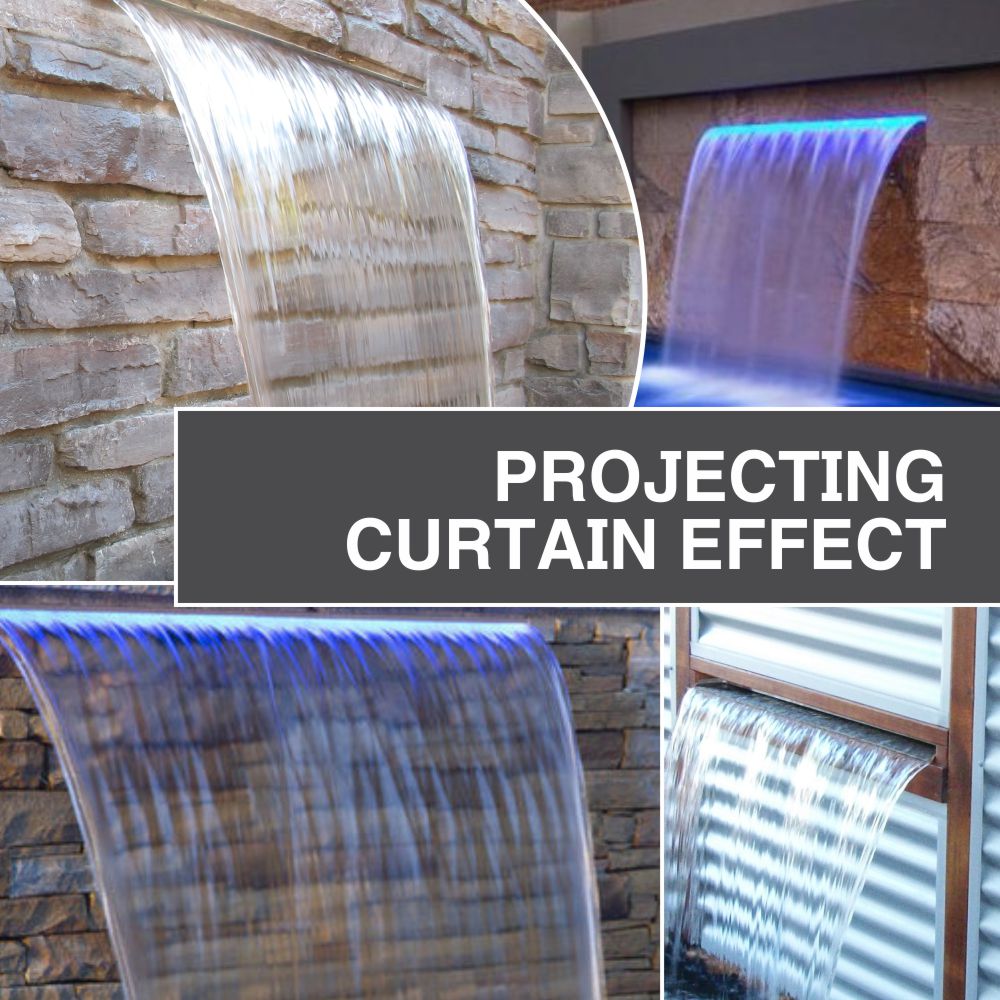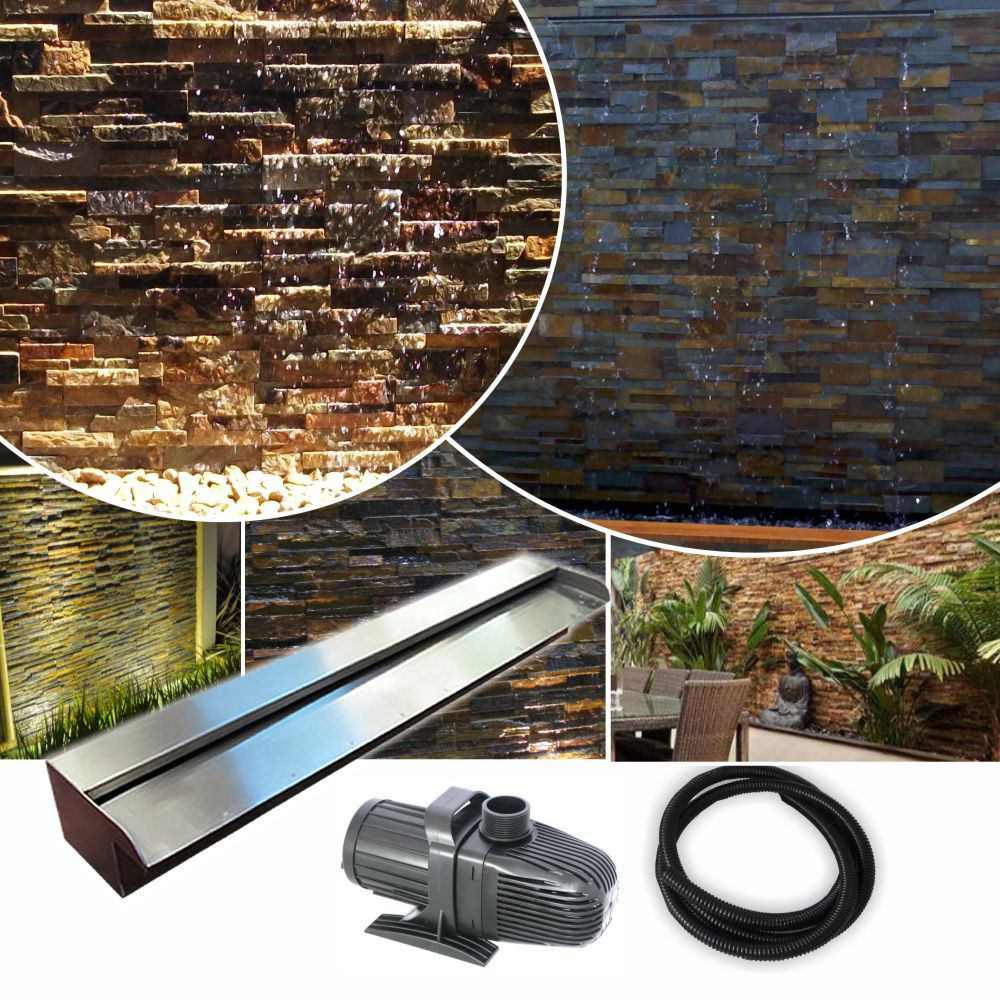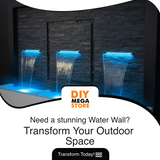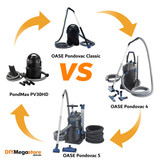Projecting Curtain Effect vs Wall Wash Effect Water Walls: Which One is Right for You?
Projecting Curtain Effect vs Wall Wash Effect Water Walls: Which One is Right for You?
Water walls are a stunning addition to any space, providing both aesthetic appeal and a soothing ambiance. However, when choosing a water wall, it’s essential to understand the different effects available and how they impact the overall design. Two common styles are the projecting curtain effect and the wall wash effect. Each offers unique visual and functional benefits, making them suitable for different settings and applications. If you're unsure which style suits your space best, speak to a water wall expert at DIYMegastore.com.au for guidance.
What Is a Projecting Curtain Effect Water Wall?

A projecting curtain effect water wall creates a sheet-like flow of water that extends outward from the feature. The water is evenly distributed over a spillway or a channel, forming a consistent and smooth cascade. This type of water feature is often more dramatic, with the water appearing to float in the air before reaching the base and water catchment.
Best Applications for Projecting Curtain Effect:
- Outdoor Spaces – Ideal for gardens, courtyards, and poolside features where the dramatic flow enhances the surroundings.
- Feature Walls – Works well as a central focus in commercial and residential environments.
- High Visibility Areas – Perfect for locations where the cascading effect can be fully appreciated.
- Wind-Protected Areas – Since the water extends outward, placing it in areas with minimal wind ensures the effect remains uninterrupted.
If you need help designing the perfect projecting curtain water wall, consult with a water wall expert at DIYMegastore.com.au.
Pros and Cons of Projecting Curtain Effect:
Pros:
- Creates a visually dramatic and striking effect.
- Works well as a centrepiece in large spaces.
- Produces a soothing sound of cascading water.
Cons:
- Can cause splashing if not positioned correctly.
- Requires more space due to outward projection.
- Less effective in windy environments.
Solution for Windy Environments:
For locations exposed to wind, a partially enclosed or recessed design can help reduce water displacement. Installing side panels or windbreaks can help keep the water flow controlled and prevent excessive splashing. Additionally, adjusting the flow rate can minimise disruption caused by wind. Speak to an expert at DIYMegastore.com.au to find the best solution for your location.
What Is a Wall Wash Effect Water Wall?

A wall wash effect water wall features a smooth, gentle flow that hugs the surface of the wall. Instead of projecting outward, the water follows the structure’s contours, creating a sleek and elegant look. This effect is often used for a more subtle, sophisticated aesthetic.
Best Applications for Wall Wash Effect:
- Indoor Installations – Suitable for lobbies, office spaces, and homes where a controlled and seamless water feature is preferred.
- Minimalist Designs – Complements modern and contemporary interiors by adding a refined touch.
- Narrow Spaces – Since the water does not project outward, this effect works well in confined areas without excessive splash.
- Noise Reduction – Creates a quieter water movement compared to the more dramatic curtain effect.
For expert advice on installing a wall wash effect water wall, visit DIYMegastore.com.au.
Pros and Cons of Wall Wash Effect:
Pros:
- Provides a sleek and elegant aesthetic.
- Minimal splashing, making it ideal for indoor spaces.
- Easier to maintain and control water flow.
Cons:
- Less visually dramatic compared to a projecting curtain effect.
- May not produce as much of an audible water sound.
- Requires a smooth surface to ensure even water distribution.
Cascade Effect vs Wall Wash Effect
The cascade effect differs from the wall wash effect primarily in how the water flows and interacts with the surface:
- Cascade Effect: Water flows down in a stepped or tiered manner, often creating a more natural waterfall-like appearance. The movement is more dynamic, with visible ripples and an audible water flow, making it ideal for outdoor landscapes or features that mimic natural water streams.
- Wall Wash Effect: Water adheres closely to the surface, creating a smooth, uninterrupted sheet of water that flows evenly down the wall. This effect is more controlled and subtle, often used in modern indoor or minimalist settings.
If you’re unsure whether a cascade or wall wash effect suits your project, consult a water wall specialist at DIYMegastore.com.au.
Choosing the Right Water Wall for Your Space
When deciding between a projecting curtain effect and a wall wash effect water wall, consider the following factors:
- Space Availability – If you have limited room, a wall wash effect may be the better choice to prevent water from splashing outward.
- Aesthetic Preference – A projecting curtain effect provides a striking visual impact, while a wall wash effect offers a more understated elegance.
- Practical Considerations – Indoor settings often benefit from wall wash effects due to their controlled water flow, while outdoor settings can accommodate the dynamic look of a projecting curtain effect.
Both styles of water walls can enhance a space’s design and ambiance, offering distinct advantages depending on the desired outcome. Whether you prefer the bold presence of a projecting curtain or the refined elegance of a wall wash, selecting the right effect ensures your water wall complements its surroundings perfectly.
For expert guidance on selecting and installing your water wall, contact DIYMegastore.com.au.
Recent Posts
-
Koi Fish Food: The Ultimate Guide for Australian Koi Keepers
Koi Protein Requirements: Complete Nutrition Guide for Australian Koi Keepers Understanding what yo …14th Nov 2025 -
Ready to Build Your Dream Water Walls?
Your water walls transformation starts with the right supplies and expert guidance. Share your water …18th Sep 2025 -
Best Pond Vacuums Compared: PondMAX PV30HD vs OASE PondoVac Classic, 4 & 5
Keeping your pond clean isn't just about aesthetics—it's essential for fish health, water clarity, a …7th Jul 2025




